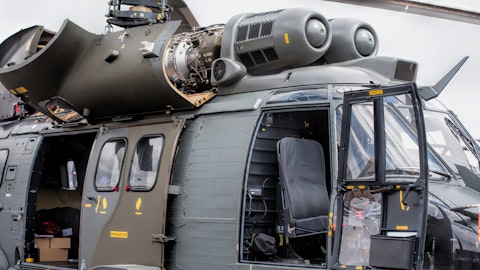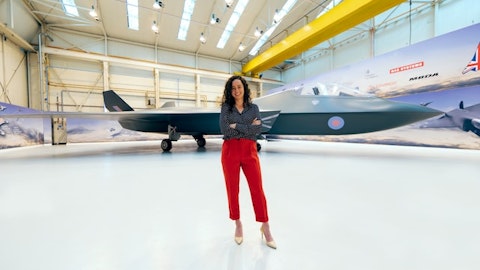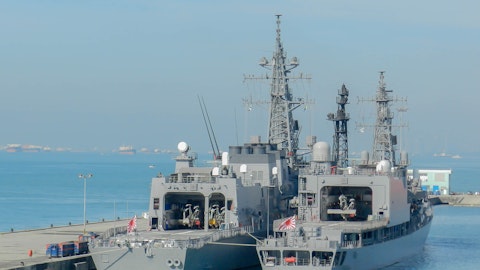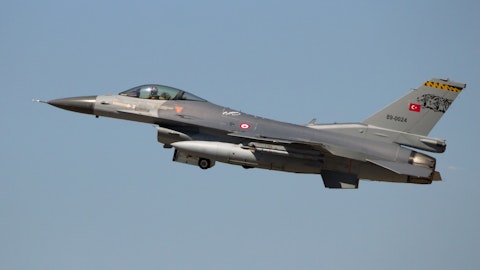Curtiss-Wright Corporation (NYSE:CW) Q3 2023 Earnings Call Transcript November 5, 2023
Operator: Welcome to the Curtiss-Wright Third Quarter 2023 Earnings Conference Call. At this all participants have been placed on a listen-mode. And the floor will be open for your questions following the presentation. [Operator Instructions]. I would now like to turn the call over to Jim Ryan, Vice President of Investor Relations.
Jim Ryan : Thank you, Lisa, and good morning, everyone. Welcome to Curtiss-Wright Third Quarter 2023 Earnings Conference Call. Joining me on the call today are Chair and Chief Executive Officer Lynn Bamford and Vice President and Chief Financial Officer Chris Farkas. Our call today is being webcasts and a press release as well as a copy of today’s financial presentation available for download through the Investor Relations section of our company website at www.curtisswright.com. A replay on this webcast also can be found on the website. Please note, today’s discussion will include certain projections and statements that are forward-looking as defined in the Private Security Litigation Reform Act of 1995. These statements are based on management’s current expectations and are not guaranteed to future performance.
We detail those risks and uncertainties associated with the forward-looking statements and our public filings of the SEC. As a reminder, the company’s results include an adjusted non-GAAP view that excludes certain costs in order to provide greater transparency in the Curtiss-Wright’s ongoing operating and financial performance. Any references to organic growth are on an adjusted basis and exclude foreign currency translation, acquisitions, and divestitures unless otherwise noted. GAAP to non-GAAP reconciliation for current and prior year periods are available in the earnings release and on our website. Now, I’d like to turn the call over to Lynn to get things started.
Lynn Bamford: Thank you, Jim, and good morning, everyone. I will begin by covering the highlights of our third Quarter 2023 performance and a brief update on our full-year financial outlook, which we are updating to reflect stronger expectations for revenue earnings and pre-cash flow generation. Then, I’ll turn the call over to Chris to provide a more in-depth review of our financial results and updates to our 2023 guidance. Finally, I’ll wrap up our prepared remarks before we move to Q&A. Starting with our third Quarter 2023 highlight, sales increased 15% overall to $724 million and improved 14% organically as we demonstrated higher year-over-year sales growth in all our end markets. Our A&D markets grew 18% year-over-year as we benefited from the continued easing of the supply chain and defense electronics, which drove strong increases in both aerospace and ground defense, as well as mid-teens growth in commercial aerospace.
We also experienced widespread growth in our commercial nuclear, process, and industrial markets, which Chris will cover in more detail shortly. Operating income grew 17% year-over-year and exceeded our strong sales growth while operating margins expanded 30 basis points. Underscored within this performance was strong possibility in defense electronics segments as we continue to overcome the dramatic impact of last year’s supply chain challenges. We continue to benefit from steady improvements in lead times and component availability within defense electronics, providing further confidence in achieving our full year outlook. Diluted earnings per share of $2.54 increased 23% year-over-year, while adjusted free cash flow was up 59%, resulting in 140% in free cash flow conversion.
We were also pleased with the continued growth in our order book, up 3% in the quarter and now up 8% year-to-date. Leading the way with our defense electronics segment, which achieved a record booking quarter exceeding the previous record set in the last year’s third quarter. This activity was driven by continued strong demand for embedded computing and tactical communications equipment. In addition, in our naval and power segment, we continue to experience strong demand for commercial nuclear products to support maintenance, modernization and plant life extensions, as well as advanced small modular reactor designs. Overall, book-to-bill was 1.2 times in the third quarter, building upon our already strong backlog, which is now up 12% year-to-date and in the excess of $2.9 billion.
Next is some highlights of our full year 2023 guidance. Our growing backlogs and strong performance today along with favorable trends across all our end markets provides us with confidence to raise our sales outlooks again. This positions us to deliver 8% to 10% top line growth with increased sales projected in all three segments. Overall, strong profitability remains unchanged with expectations for 10 to 30 basis points in year-over-year margin improvements reflecting the balance of the combined portfolio, whereby a reduction in the naval and power segment profitability was offset by a stronger outlook in defense electronics. As a result, diluted EPS is now expected to grow 11% to 13%, which as a reminder keeps us on track to exceed our long-term targets.
In addition, for the second consecutive quarter, we increased the bottom end of our already strong free cash flow guide to reflect the year-to-date performance and higher confidence in the full year outlook. In summary, Curtiss-Wright remains well-positioned to deliver another strong performance in 2023. Now, I would like to turn the call over to Chris to continue with our prepared remarks.
Chris Farkas: Thank you, Lynn. On slide four, we have the key drivers of our third quarter 2023 performance by segment. I’ll begin in aerospace and industrial, where overall sales growth of 3% was in line with our expectations. Within the second commercial aerospace market, we experienced double-digit growth in OEM sales supporting the ramp-up in production on Boeing and Airbus platforms, most notably on the Airbus A320 and A350 programs. We also experienced higher sales in the general industrial market driven by solid growth in EM actuation products and surface treatment services. Partially upsetting those increases was a decline in actuation sales within the segment’s aerospace and ground defense markets due to the timing of production on various programs.
Turning to the segment’s profitability, favorable absorption on higher sales was offset by unfavorable mix in the timing of development contracts, principally for actuation products. Next, in defense electronics segment, sales increased $55 million or 34% reflecting continued supply chain recovery in the conversion of our strong order book, which showed increases in our aerospace and ground defense markets. Of note, and included within that strong performance, approximately $10 million in practical communications equipment sales were accelerated into the third quarter from the fourth quarter as we burned down some of our backlog at a faster pace. Elsewhere in aerospace and ground defense, we experienced increased sales with embedded computing equipment, most notably on the Stryker platform, which is another example of the strong demand from our customers for our MOSA compliant solutions.
Within aerospace defense, we experienced strong sales growth for embedded computing equipment on various domestic and foreign military programs, as well as flight test instrumentation on the F-35 program. Regarding the segment’s operating performance, operating income increased 54% while operating margin improved 330 basis points, principally due to favorable absorption on the strong sales growth. Also included within those results was a year-over-year increase of $4 million in strategic IR&D investments to enable our future organic growth. Turning to the naval and power segment, overall sales growth of 12% was essentially in line with our expectations in reflected growth in both our AMD and commercial end markets. Within the segment’s aerospace defense market, our arresting systems business continues to perform extremely well based upon the strong global demand for our products.
In the naval defense market, our results reflected higher revenues supporting the ramp-up on the Columbia-class submarine and solid growth on the Virginia-class subs, partially offset by the timing of production on the CVN-81 aircraft carrier program. In the power and process market, sales increased approximately 10% overall and inflected mid-teen sales growth when excluding the revenue headwind from the wind-down of CAP1000 production. These results reflected continued strong demand in our commercial nuclear market supporting the operation maintenance of existing reactors, as well as higher development revenues mainly supporting the X energy advanced reactor design. We also experienced strong sales growth in the process market driven by increased refinery maintenance and turnaround activity, as well as higher subsea pump development revenues.
Turning to the segment’s operating performance, favorable absorption on solid sales growth was partially upset by unfavorable necks from the CAP1000 program. In addition, if you look at the segment’s profitability, our results reflect a small number of naval contract adjustments, reflecting the continued training and development in new hires to support our ramp and growth. To sum up the third quarter results, overall, strong growth in operating income once again exceeded growth in sales and resulted in 30 basis points in year-over-year operating margin expansion. Next, turning to our full-year 2023 guidance on slide five. I’ll begin with our in-market sales outlook, where we now expect organic sales to grow 7% to 9% with total sales growth of 8% to 10% of $30 million for 1% compared with our prior guidance.
Across the entirety of our aerospace and defense markets, we now expect total sales to increase 10% to 12%. Taking a closer look at the aerospace defense market, we’ve increased our expectations for full-year sales growth to range from 11% to 13% based on strong demand for arresting systems equipment and higher embedded computing revenues and defense electronics. Next, in ground defense, we now expect an even more favorable full-year sales growth of 23% to 25% driven by the continued strong demand for our tactical communications equipment and easing in the supply chain. Of note, based on the accelerated receipt of materials and timing of revenue that’s shifted into Q3, we expect sales in the ground defense market to decline potentially in the fourth quarter.
Next, in naval defense, while we expect a solid 5% to 7% outlook for year-to-year growth, we reduce the outlook slightly, namely due to the timing of production on the CVN-81 aircraft carrier program as we now expect some revenues to shift out of 2023. Before we wrap up our defense markets, I wanted to highlight an area where we’ve received a number of questions over the past year since the start of the opening conflict and commitment by NATO countries to increase defense spending as a percentage of GDP. As anticipated, we’ve steadily seen an increase in strong contribution in direct foreign military sales as we progress through the year. Collectively across Curtiss-Wright, we now expect these sales to grow approximately 15% year-over-year.

And the notable drivers of this spending include higher sales of avionics, flight test equipment, and arresting systems in aerospace defense, turret drive stabilization systems on ground defense platforms, and aircraft handling systems on naval vessels. Given the rising threat environment and alignment of our technologies to domestic and foreign defense priority, we continue to see this as an opportunity to address solid long-term revenue growth in this area. Turning to commercial aerospace, based upon the year-to-date performance, we are now increasing our expectations of sales to grow 14% to 16% driven by strong OEM sales growth on both narrow-body and wide-body platforms. Outside of our A&D markets, we raised our growth outlooks slightly for the power and process market based on the continued strong demand for both our commercial nuclear and industrial valve products.
And as a reminder, the outlook in this market includes the $20 million year-over-year revenue headwind from the wind down on the CAP1000 program as we substantially completed this contract in the first quarter. Excluding that impact, we expect a high single-digit full-year growth rate in our commercial nuclear market, as well as a low double-digit growth rate in the process market, reflecting higher nuclear outages and process turnarounds, as well as a ramp in development of advanced SMRs. Overall, across our total commercial markets, we continue to expect full-year sales growth of 3% to 5%. Continuing with our full-year outlook by segment on slide six, I’ll begin in aerospace and industrial where we increase our range of sales slightly to reflect the strong demand in the commercial aerospace and continue to expect solid sales growth of 4% to 6%.
Regarding the segment’s profitability, we maintained our full-year outlook reflecting strong growth and operating income in 20 to 40 basis points in operating market expansion. We continue to expect the segment to deliver a strong fourth quarter and finish to 2023. Next, in defense electronics, we raised our revenue forecast again, and now expect sales to grow 12% to 14% based upon the strong year-to-date performance, continued improvement in the supply chain, and record-level order activity. Regarding the segment’s profitability, we now expect operating income to grow 18% to 21%, and full-year operating margin to range from 23.5% to 23.7%, reflecting 110% to 130 basis point in year-over-year expansion, which is 50 basis points above our prior expectations.
As noted earlier, based on the segment’s stronger-than-expected third quarter results, we expect sales to decrease sequentially in Q4, but still demonstrate strong profitability with an operating margin of approximately 30%. And lastly, in naval and power, we increased our range of sales slightly to reflect the aforementioned changes in end markets and continue to expect strong sales growth of 8% to 10%. Regarding the segment’s profitability, while we anticipate favorable absorption on the overall increase in sales, we reduced our operating income guidance to now reflect flat to 3% growth and trimmed our prior margin outlook by 40 basis plants, primarily due to the timing and efficiency on a small number of naval contracts. While the impact of the contract’s adjustment is immaterial to overall Curtiss-Wright guidance, we see this as an opportunity going forward, which Lynn will adjust further in her closing remarks.
And lastly, in regard to the segment’s margins, our outlook continues to reflect margin pressures associated with the timing and development contracts in the power and process market, and unfavorable mix on lower CAP1000 revenues. Regarding the increase in non-segment or corporate expenses, our updated guidance reflects an increase in assumptions related to higher-than-anticipated foreign exchange transactional losses in 2023, which we now expect to fully offset lower year-over-year pension costs. So to summarize our outlook, we continue to expect total Curtiss-Wright operating income to grow 8% to 11% overall in 2023 in excess of sales growth. And as a reminder, this outlook includes a year-over-year increase of more than $20 million in our total engineering spend on both internal and customer-funded programs and remains in line with our initial guidance provided earlier this year.
Despite that offset, we expect to drive 10 to 30 basis points in full-year operating margin expansion as we continue to deliver on our 2021 investor date commitments. Continuing with our financial outlook on slide seven, and building upon our solid year-to-date performance and expectations for a strong finish to the year, we have increased our full-year adjusted diluted EPS guidance to a new range of $9 to $9.20 for up 11% to 13%. And lastly, during the free cash flow, we delivered a strong performance through the first nine months of 2023 that puts us back in line with our more historical cadence. As a result, we raised the bottom end of our range by $10 million to reflect improved confidence following increases to our full-year financial outlook and our intense focus on working capital management.
Our adjusted free cash flow outlook now ranges from $380 to $400 million to reflecting strong growth of 29% to 36%, and is also within striking distance of our record of nearly $400 million achieved in 2020. Our updated guidance continues to imply a free cash flow conversion rate in excess of 110%. Now I’d like to turn the call back over to Lynn.
Lynn Bamford: Thank you, Chris, and turning to slide eight. As we have discussed today, we achieved strong third-quarter results and remained on track to deliver another outstanding year for our shareholders. It’s worth reiterating that we expect to deliver these strong results while maintaining our commitment to incremental investments in R&D, which further strengthens our ability to sustain organic growth well into the future. As I reflect upon the challenges that we and many defense companies are facing today, ranging from supply chain to staffing, I’m incredibly proud of the accomplishments of the team. Our ability to pivot, to deliver strong growth, and the effort we put forth to accomplish our 2021 Investor Day commitments.
When leading in a growth environment amidst a dynamic global market, there are always challenges to be faced. For example, the events of the pandemic led to the unfortunate turnover of nearly 15% of our workforce. Within these types of challenges, we have consistently found opportunity to advance both financial and operational excellence with the goal of improving Curtiss-Wright overall efficiency and resilience. We continue to focus on enhancing our processes, programs, and systems to ensure that the team is fully engaged and supported as we’ve reshaped the workforce. We have done so with increased efficiency while driving record high sales. As we prepare to meet strong demand ahead of us, we’ve added back about half of those jobs lost during the pandemic, many of which are engineers.
We continue to see encouraging trends in employee hiring, retention, and turnover, and this remains critical as we continue to ramp up our focus on new projects and opportunities which will drive our growth well into the end of this decade. Further, we are committed to continuing to refine our processes as we onboard employees and implement new training programs to assure we develop the future generation of Curtiss-Wright workforce. As I near the end of my third year as CEO of Curtiss-Wright and look out across the portfolio to our future, it is clear that we are well-positioned to continue to capitalize on the tremendous secular growth trends driving our A&D and commercial end markets. Before we wrap up, I’ll highlight a few of those avenues for growth.
In defense, an increasing global focus on security and our position as a trusted proven supplier provides confidence in our ability to deliver strong, long-term growth across our defense businesses. As you can see by our performance this year, we’re certainly benefiting from the strengths and alignment of our portfolio to the FY 2023 spending bill, which appropriated $817 billion, or 10% year-over-year growth for the DOD budget. Although we’re faced with the current continuing resolution and delayed signing of the FY 2024 spending bill, we remain in an elevated U.S. defense budget environment, with the proposed legislation [ph] calling for at least 3% top-line growth in FY 2024. We see continued opportunities to support our efforts in naval shipbuilding, the expansion of our MOSA products offering in defense electronics, as well as ground modernization to name just a few.
The trends driving global defense spending, most notably by the U.S. and its NATO allies, are expected to remain a strong tailwind for Curtiss-Wright in the industry. In commercial aerospace, growth in global passenger travel, the need to replace the aging commercial fleet, and our drive to expand our capabilities on existing and new platforms is expected to provide continued growth for years to come. Further, the emergence of electrification in aerospace and defense provides yet another opportunity to expand Curtiss-Wright’s technological reach, building upon our relationships and new product introductions addressing the electrification of vehicles in the general industrial market. As I look to commercial nuclear, emerging technologies in nuclear power and the tremendous efforts to exist worldwide to truly impact global decarbonization and energy security provide a long runway of opportunities for Curtiss-Wright.
This includes opportunities to support large-scale AP1000 reactors in Europe, as well as the large volume of advanced small modular reactors, expected to be built to supplement the existing nuclear reactors or replace existing coal plants, all of which will be needed to meet the tremendous global demand for energy. Level of activity for commercial nuclear continues to advance at a relatively rapid pace, and we remain aligned as a strategic supplier to support our customers’ needs. Finally, I’m pleased to share that just this week, Bulgaria’s government announced that they have approved the construction of their first AP1000 reactor, which is anticipated to be operational by 2033, followed by a potential second reactor expected to go online two or three years after the first one.
This exciting news follows Poland’s earlier selection of the AP1000 reactor and their recent timing of an engineering service contract with Westinghouse for the construction of the first three of potentially six AP1000 reactors. Those initial reactors are expected to be operational in the early 2030s. Bulgaria’s news provides yet another positive endorsement for the AP1000 technology, while also reaffirming Curtiss-Wright opportunity to secure multiple contracts for our reactor coolant pumps within the next two to four years. In closing, I’m pleased with our continued momentum and the healthy outlook for the near and long-term prospects for Curtiss-Wright and the markets we serve. Across every avenue, we are diligently investing in our employees and in critical technologies today to support our future, which will enable Curtiss-Wright to deliver long-term profitable growth and tremendous value for our shareholders, our employees, and our customers.
Based on our strong outlook in 2023, we continue to maintain line of sight to the three-year Investor Day commitments established in 2021, providing confidence that our pivot to growth strategy is working. We look forward to providing a recap of our results and performance against our three-year targets in February, followed by our May 2024 Investor Day in New York. Thank you. And at this time, I would like to open up today’s conference call for questions.
See also 15 States With the Most Expensive Gas in the US and 11 Best Military Drone Stocks To Invest In.
Q&A Session
Follow Curtiss Wright Corp (NYSE:CW)
Follow Curtiss Wright Corp (NYSE:CW)
Operator: The floor is now open for questions. [Operator Instructions] Thank you. Our first question comes from Peter Arment with Baird. Your line is open.
Peter Arment: Yes, thanks. Good morning, everyone. Hey, congrats on the nice results. Lynn, when you think about the nuclear business. Just thinking back to the days when we had the big China direct order and you look at the kind of outlook over the next several years, I know – how do you think about in terms of sizing the opportunity? It certainly seems like there’s just a lot more going on and multiple opportunities, whether you look at the AP1000 or you look at SMRs. How are you framing it?
Lynn Bamford: So, the potential is actually very significant, and we’re very encouraged to see the steady drumbeat of this wide group of opportunities for RCP pumps to keep across all the fronts. You know, there’s multiple countries. We talked about Bulgaria and Poland on the call here, but Ukraine, Romania, the Czech Republic, even in the UK, Slovenia, Slovakia, Finland, and Sweden are all, you can find press on all of them that they are taking steps to move forward with building significant new nuclear power. Some of those are still in a competitive position, but Westinghouse clearly continues to begin – continue to win across that market, given the track record and the great safety profile of the AP1000 nuclear power plant.
Today, we think there’s potentially a room for 50 to 100 RCPs, and this is well into over a billion dollars, and potentially north of $2 billion of business for Curtiss-Wright. And it’s a pretty consistent timeline that the countries seem to be targeting on getting these plants online in the very early 2030s. So the significance of bringing some meaningful order to Curtiss-Wright is similar to what we saw with the China Direct order, or even more is coming in the next two to four years, and we’re making sure we’re prepared to be a great partner for Westinghouse and ready to ramp up and to do that. So it’s fairly dramatic when it comes. It’s going to be an amazing flash point for Curtiss-Wright. And the timeline, we said three to five years.
At the beginning of 2022, we’re now saying two to four years, and things consistently are just moving forward. It’s not — as if a year passes, and the timeline still remains three to five. We feel good that this is moving in a very meaningful direction.
Peter Arment: Appreciate that. And just on your overall defense business, are you seeing any kind of replenishment activity? I know there’s a lot of activity that we’re sending over to Ukraine and giving everyone’s kind of interest of what’s going on in the Middle East. Are you guys seeing any impact in the order environment?
Lynn Bamford: We’re not heavily to be transparent, that you are not in munitions and the type of stuff that is being very much replenished. However, we are in a lot of the equipment that is very much needed, and whether that’s from tactical communications types of equipment, definitely seeing some order trends there to many of the missile defense systems where we have significant content. So it’s a little, it’s not the quick reaction stuff that is being asked for, but definitely Chris spoke to the increased trends. And one of the other areas outside of defense electronics, we tend to think about, but clearly, our new ESCO acquisitions, say 75% of their business is outside of the U.S. They’re having an absolutely knock the doors kind of year and a lot of that is, you know, countries throughout Europe trying to assure their positions for readiness and their equipment is essential for that.
So clearly that is the position there has been driving orders into our ESCO business.
Peter Arment: Thanks. And just one quick last one, Chris. You guys continue to generate obviously very strong free cash flow. Are you still seeing opportunities kind of, whether it’s working capital base or how do you think about just working capital profile going forward?
Chris Farkas: Yes. I’m pretty pleased with the performance and what we’ve been able to accomplish here today. I mean, just even looking at Q3 and that high, you know, free cash flow that we generated, which I think if you look back over the past five years is stronger than most. But year-over-year, we were able to reduce our working capital as a percentage of sales in the third quarter by approximately 300 basis points, and with the increase in sales and what’s happening across the organization to support the ramping growth, it really didn’t come through collections. Collections is certainly an opportunity for us on a throughput basis, but we’ve got a lot to close out here in year-end. It really came through lower inventory.
So I think we’re starting to make some progress. You’re going to see that in the throughput of the product. And as we get to year-end here, we’re expecting to finish in that 24% range, showing 200 basis points of year-over-year improvement. A lot of that will be burning off this great collection of opportunity that we have in front of us now and inventory burn down. I don’t know that it will be quite as aggressive as we have been in the past with payable stretching We were pretty tough with our suppliers this last year, and I think, given our situation here, it’s good to maybe not be quite so aggressive. But, yes, there is opportunity ahead of us. I mean, I think we still have more opportunities as we head into 2024 to burn down inventory and to get this working capital as a percentage of sales back in line with some of those historical bests that we were hitting back in that 2019 time frame, so, more to come.
Peter Arment: Appreciate the details. Thanks.
Lynn Bamford: Thanks, Peter.
Operator: Our next question will come from Kristine Liwag with Morgan Stanley. Your line is open.
Kristine Liwag: Hey, good morning, everyone.
Chris Farkas: Good morning Kristine.
Kristine Liwag: You know, so Lynn, I just want to go back in terms of the timing for the AP1000 order. Is Bulgaria and Poland both want to have the power plant online in the early 2030s? I mean, it seems like they should have to order the reactor coolant pump right now. So, just want to understand a little bit more on timing and regarding the progress of your discussion with them. Could this be a late 2023 or even a 2024 order?



